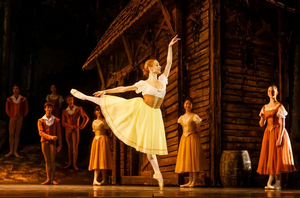Review: STAATSBALLETT BERLIN'S GISELLE at Staatsoper Berlin
Iana Salenko, Daniil Simkin, culture in quarantine, socially distanced theatre, Staatsballet Berlin, Peter Farmer, Patrice Bart, Aurora Dickie

![]() I had been vividly envisioning my return to live theatre for seven months before attending Staatsballett Berlin's performance of Giselle. However one scenario I had not accounted for was that my first show back, would also be the last for a while, as Germany is plunged into another "lockdown light" in just a few days.
I had been vividly envisioning my return to live theatre for seven months before attending Staatsballett Berlin's performance of Giselle. However one scenario I had not accounted for was that my first show back, would also be the last for a while, as Germany is plunged into another "lockdown light" in just a few days.
For the meantime however, there was much to enjoy in Patrice Bart's deeply traditional Giselle (first premiering 20 years ago) that has been especially adapted to deal with the constraints of COVID; Non-dancing background artists wear masks, Giselle's mad scene sees her carefully avoid contact with any bystanders other than her mother, and the corps de ballet performing the roles of the Wilis' seen in Act Two have been cut from 24 to 12 in order to create sufficient space on stage.
For this opening night, and Staatsballett Berlin's first full length ballet since March, the 500-strong social distanced audience are treated to luxury central casting. Iana Salenko brings fragility and innocence to an awestruck Giselle in Act One, while Daniil Simkin thrills in Act Two with clean, crisp jumps, his legs snapping together so clearly in lofty cabrioles that they can be heard by the audience. Together their chemistry is slow burning, more of a tender affection than anything dramatic but they are endlessly charming and engaging to watch together.
Set against the simple but elegant designs of Peter Farmer, the production has a wistfulness about it. Perhaps it's 7 months without culture but there was escapism to be found in the quaint village setting. Giselle's friends pleasantly waft in billowing dresses, Aya Okumura & Alexander Bird add quality in the demanding Bauern-Pas-de-deux and the imposing presence of Filipa Cavaco's Bathilde is suitably regal and detached.
In contrast, Salenko's Giselle is sweet and pure, admiring Bathilde's coat with a genuine innocence. Later she is visibly consumed by her grief at Albrecht's betrayal.
Despite the noticeably emptier stage in Act Two, the well-drilled formation of Wilis' still makes the production easily recognisable as a Giselle. Aurora Dickie's Myrtha is stoic and commanding, as impactful through her mime as through her dancing. The recognisable arabesque hops which sees the dancers cross one side of the stage to the other have been staggered and some sections don't travel in order to maintain a safe distance. In some ways, the opportunity to observe individual members of the corps de ballet more closely than when hidden in a crowd of 24 was an unexpected positive.
The obvious highlight here however is Simkin's powerhouse solo. He springs across the stage, all those reserves of energy from lockdown coming to full fruition. It's an outrageously impressive display with explosive jumps and endless, controlled pirouettes that provoke vocal approval from the audience.
Getting this particular Giselle to the stage is undoubtedly a minor miracle, and there is much to admire in the dedication of the company for persevering in order for audiences to absorb the blissful few hours of ebullience on offer. For now we wait, until Berlin can be treated to more of the same.
Giselle ran on 28, 29 and 30 October at the Staatsoper Berlin. Check the Staatsballett website for details of future performances.
Image: Yan Revazov, courtesy of Staatsballett Berlin
Reader Reviews
Videos

